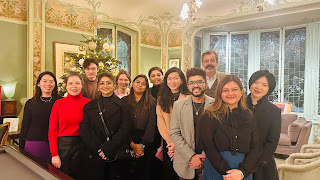“Fashion and Craftsmanship: Two inseparable stories”
Maison Lesage, where excellence meets unique craftsmanship, is France’s most revered haute couture embroidery workshop. Since its creation in 1924, the maison and its embroiderers have been using unique savoir-faire to embellish houses like Madeleine Vionnet, Chanel, Elsa Schiaparelli, Dior, Yves Saint Laurent, Cristobal Balenciaga, etc.
Housed in the unique building of 19M, Lesage pays true homage to the Métier d’arts, Mode (fashion), and Main (hand; artists and savoir-faire). The visit was a unique opportunity for the participants of the Luxury Brand Management track to travel through the evolution of fashion and learn about the indispensable role of craftsmanship in bringing a designer’s vision to life. In 1992, the company founded an embroidery school, Ecole Lesage, open to anyone who is passionate about learning the savoir-faire of embroidery. ESSEC participants witnessed a live demonstration of a complex technique by one of the teachers of the école. This illustrated how the complexity of this savoir-faire elevates ordinary clothes to haute couture. The director of Ecole Lesage shared some extraordinary samples from maisons Michonet, Elsa Schiaparelli and Chanel from their beautifully preserved archives.
Post a lively lunch in the 19M canteen, the visit continued to the workshops of the Maison Lesage, where the participants observed various steps involved in bringing the vision of a designer from ideation to conceptualization. It is here that you witness the countless number of hours spent, hands involved, and all the tassels, rhinestones, ribbons, pearls and crystals that make up in bringing together an haute couture creation that would in some weeks glide through the runways of the fashion world.
A shimmering crystal in the fabric of Maison Lesage is Vastrakala, a fine embroidery workshop created in 1993 in Chennai, India by Jean-François Lesage. The workshop symbolizes a unique synergy between the unique savoir-faire of French master embroiderers and the immeasurable talent in Indian hands.
The visit concluded with a workshop, where the participants had the opportunity to recreate a small piece of embroidery, which they were able to keep as a souvenir, under the masterful guidance of the craftswomen of Maison Lesage. This manual activity reinforced the immeasurable skills, dexterity and expertise mastered by the true craftsmen and women of haute couture. This visit was one of the most fascinating and crafty of them all!
On to the next one…
Written by Japanjot Kaur, ESSEC GMBA student


















